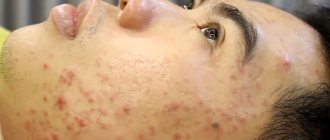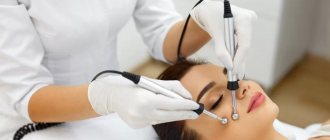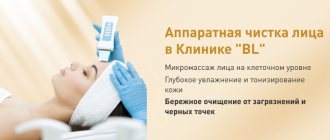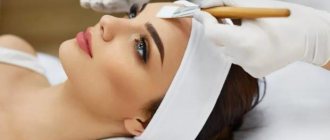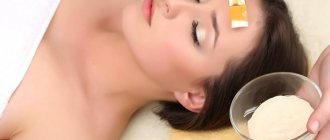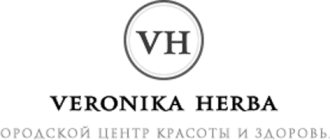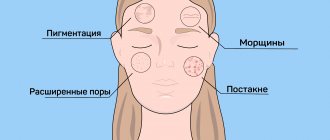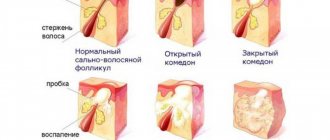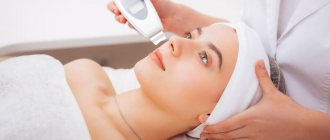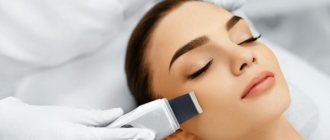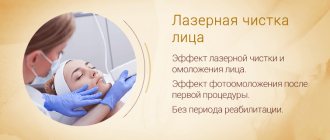From this article you will learn:
- The essence of mechanical facial cleansing
- Advantages and disadvantages of mechanical facial cleansing
- Indications and contraindications for mechanical facial cleansing
- Mechanical facial cleansing by a cosmetologist and at home
- Skin care after mechanical facial cleansing
Mechanical facial cleansing today is a basic care procedure that is offered in every beauty salon. All girls know that for high-quality cleansing of clogged pores and skin from dead cells and dirt, simple washing is not enough. Cleaning allows you to get rid of many possible problems.
This technique allows you to penetrate deeply into pores and eliminate impurities that even an ultrasound machine cannot cope with. The procedure is very effective in the fight against acne. However, like any cosmetic intervention, it has its pros and cons, but first things first.
What's happened
Facial cleansing in a salon is a procedure during which not only various impurities, but also dead cells are removed from the surface of the skin. As a result of the accumulation of these elements, the skin ceases to receive all important substances in the required quantities along with creams, lotions and masks.
Facial cleansing should not be only manual. This severely injures the skin. It is necessary to combine manual techniques with more gentle methods of influence.
Dermatovenerologist, cosmetologist
Zhikhoreva Inna Viktorovna
6 years experience
This procedure is needed to unclog clogged pores and can be used in cosmetology regardless of skin type.
During its implementation, specialists pay increased attention to inflamed areas. In addition, the procedure helps restore blood circulation and activate metabolic processes that occur in the layers of the epidermis.
Indications for cleaning
INDICATIONS
- increased oiliness of the skin;
- enlarged pores prone to the accumulation of dirt and dust particles;
- the presence of blackheads (comedones) and sebaceous plugs;
- increased activity of the sebaceous glands;
- acne during remission;
- dull complexion.
These are indications for facial cleansing on any skin type. But oily skin needs cleansing most of all, in which case it should be done at least once a month. It is recommended to clean normal skin once every 2-3 months, and dry skin no more than once every three to four months.
Types and progress
The facial cleansing procedure in a beauty salon is divided into several types, including the following.
Mechanical
This type is also called manual technique. It lies in the fact that the cosmetologist performs all manipulations using his hands or certain tools. Typically, various loops, a Uno spoon or a Vidal needle are used.
The whole process is carried out as a result of the peeling effect on the skin, during which all imperfections of the epidermis are squeezed out.
A distinctive feature of this technique is that it allows you to eliminate any shortcomings, for example, rashes, pimples, ulcers. In addition, this procedure makes it possible to get rid of blackheads without developing the consequences that may arise after facial cleansing at home.
Progress
To perform this manipulation as efficiently as possible, the cosmetologist must follow certain rules for its implementation.
First, the surface of the face must be treated with hydrogen peroxide or any other antiseptic solution that is suitable for your skin type.
After this, if there are closed comedones, they need to be pierced. A Vidal needle is used for this.
A loop or spoon of Uno is applied to the skin so that the comedone is located under the round hole of the instrument.
How often should you cleanse your face?
Homemade facial cleansing with a scrub cannot be an alternative to salon procedures.
The cosmetologist exerts a certain influence on the device and squeezes out the plug. Depending on what type the formation belongs to, its contents may have a thick or liquid consistency.
After the required area is cleaned, it is treated with an antiseptic solution. This may be alcohol, Miramistin or Chlorhexidine. The tools used must also be wiped down.
When the sebaceous plugs are completely removed, a special mask is applied to the face, which has an anti-inflammatory, thinning and drying effect.
Vacuum
Facial cleansing with this method is done only if there are minor skin problems and there is no inflammatory process.
This technique involves cleansing by sucking out impurities from the pores. The manipulation takes place without pain and with minimal redness of the epidermis.
Stages of implementation
First, the skin is exposed using a special device that supplies low-frequency current. This allows you to open the pores as much as possible to remove sebaceous plugs.
After this, the required area is treated with a vacuum apparatus with various attachments, which specialists select based on skin type. Thanks to this, the pores are cleaned, which makes it possible to get rid of acne, unevenness and wrinkles.
Why can our articles be trusted?
We make health information clear, accessible and relevant.
- All articles are checked by practicing doctors.
- We take scientific literature and the latest research as a basis.
- We publish detailed articles that answer all questions.
After all the main contaminants have been removed, the specialist carries out manipulations to remove dead cells. To do this, he uses chemical peeling, which is also selected depending on the type of skin.
Ultrasonic
Professional facial cleansing with this method is carried out using a special device that emits certain waves necessary to perform this type of procedure.
A gel or tonic with mineral water containing a peeling solution is applied to the skin. It is due to the influence of this composition that the necessary exfoliating effect is achieved.
The desired area is treated with a special device that emits waves of a certain frequency using massage movements.
When is the best time to cleanse your face?
Facial cleansing is an important medical procedure that is necessary for everyone, regardless of skin type.
After the manipulation, a mask with a soothing effect is applied to the skin, which helps to narrow pores and eliminate inflammation and impurities.
How long the result will last will depend on the type of epidermis and subsequent care for it. If a woman has oily skin, 2-3 sessions will be needed. For dry or normal skin, it is enough to do one procedure per month.
Brushing
This is a type of cosmetic facial cleansing that uses a device with a special brush attachment. Due to the fact that the speed of rotation of the head can be changed, this technique allows you to remove impurities from the upper layers of the epidermis and cleanse the pores. Despite the fact that the brush has an intimidating appearance, the process is delicate and does not injure the skin.
Laser
Refers to painless procedures that are carried out without direct contact with the skin. Infection when using this technique is minimal. The laser penetrates deep into the cells, which helps restore them, as well as normalize the functioning of the sebaceous glands.
The method of the procedure is that when exposed to a laser beam, dead layers are destroyed, which stimulates the renewal and rejuvenation of the dermis.
Progress
Before starting work, the specialist puts on protective glasses for himself and the patient. After this, the device is configured. To check the intensity of the beam, a small area of skin is taken.
The session lasts about half an hour. At the same time, a person can feel warmth. There is no pain.
Once the desired area has been completely treated, a soothing mask is applied to it. This will narrow the pores as much as possible and prevent the penetration of pathogenic bacteria into the inner layers.
If the patient has a low pain threshold, the affected area is treated with an ointment or cream with an anesthetic effect.
Cryopilling
The procedure is carried out using liquid nitrogen. When exposed to low temperatures, facial skin is cleansed.
The cosmetologist begins to treat problem areas with a swab pre-moistened in the solution. This leads to improved metabolic processes and blood circulation, elimination of inflammation and neutralization of potential purulent foci.
Chemical
This method involves applying certain drugs, usually low concentration acids, to the skin.
The procedure itself is performed in several stages.
Light peeling
First, a mask with a weak solution of fruit acid is applied to the face. This is necessary in order to dissolve fat and soften the stratum corneum.
Repeated
Concentrated acid is applied. This is necessary to warm up the face, remove sebaceous plugs and exfoliate dead particles.
Enzymatic
A special composition with whey protein is used. It makes it possible to cleanse the deeper layers of the epidermis and dissolve sebaceous plugs. In addition, this product helps soften and moisturize the skin.
Disinfection
The surface that has been cleaned is wiped with a herbal lotion, which has disinfecting, softening and regenerating properties.
Recovery
A soothing mask is applied to the face, which is selected based on skin type. It helps prevent inflammation, moisturize and soften the skin.
Powder or cream can be used, which creates additional protection against the negative effects of environmental factors.
Mechanical cleaning
This type of skin cleansing in cosmetology is also called manual or manual cleansing. It is carried out manually, using a special tool to remove deep-seated comedones and sebaceous plugs. Cleaning steps:
- preliminary cleansing;
- applying masks according to skin type;
- steaming the skin or applying a special cream;
- performing cleaning;
- applying a softening/moisturizing cream or mask to the skin to soothe the skin.
If we are talking about which facial cleansing is best for blackheads, here the palm goes to the procedure that is carried out mechanically.
This cleansing method allows you to remove even deep-seated pimples and blackheads. However, manual cleaning has a disadvantage: it is quite painful and leaves behind redness and swelling of the skin. It takes several hours for the skin to recover. After cleaning, it is not recommended to apply decorative cosmetics to the face or scrub. In the first 2-3 days, it is better to refrain from visiting the bathhouse, swimming pool or sauna. Before going outside in sunny weather, you should apply sunscreen to your face.
Contraindications
Despite the fact that salon techniques are common and in demand, they are not suitable for all people.
Which is better: peeling or facial cleansing?
Cosmetology clinics and beauty salons offer a wide variety of facial skin care procedures.
Thus, among the most common contraindications, cosmetologists identify:
- diabetes ; _
- pathologies of the heart and blood vessels;
- dermatological problems ;
- upper respiratory tract diseases.
It is prohibited to carry out such a professional procedure during pregnancy and breastfeeding.
You should make a decision about using one or another method of cleansing your facial skin only after receiving advice from a specialist. Independent choice can lead to serious complications.
Proper preparation
Regardless of which facial cleansing technique will be used, in order for the final result to be as effective as possible, it is necessary to properly prepare for the session.
First of all, the specialist examines the skin, determines its type and, taking these factors into account, offers the optimal type of procedure. If necessary, he can direct the patient to undergo certain tests and undergo instrumental examination to identify certain diseases for which such manipulations cannot be performed.
If there are no restrictions, then you will need to give up tanning both in a solarium and in direct sunlight, drink alcoholic beverages, and also stop using certain cosmetics within a few days.
The skin of the face also requires appropriate preparation.
Pros and cons of professional facial cleansing
Cleaning is one of the most common procedures in the field of cosmetology, with which you can get rid of most skin problems.
For this purpose, the cosmetologist must first of all thoroughly disinfect all the instruments that will be used in the process. To do this, take an antiseptic solution.
It is important to thoroughly cleanse the skin and remove residual makeup, sebum and impurities.
The stratum corneum, which requires preliminary softening, is not left without attention.
Galvanic cleaning
This type of facial cleansing is carried out using an alkaline solution that is applied to the skin, as well as low-power galvanic currents. Fatty deposits and dirt particles accumulated in the pores are pushed out to the surface under the influence of current. Galvanic cleansing is useful not only for oily skin prone to inflammation and acne. Its implementation also contributes to:
- improvement of lymphatic drainage and microcirculation;
- normalization of the activity of the sebaceous glands;
- synthesis of collagen and elastin;
- restoration of water-lipid balance;
- smoothing facial wrinkles;
- improving metabolism in the tissues of the upper layer of facial skin;
- increasing the firmness and elasticity of the skin.
One of the disadvantages of galvanic cleansing is its drying effect, so the procedure should not be carried out more than once a month, even if we are talking about oily skin. For dry skin, it is better to choose other types of cleansing, since exposure to galvanic current increases the risk of irritation, redness, peeling and itching.
Skin care after
To reduce the risk of complications and maintain the results for as long as possible, additional skin care is required. To do this, experts recommend adhering to certain simple rules:
- cleanse your face in the morning and evening;
- use tonic and moisturizing products suitable for your skin type after performing hygiene procedures;
- use cosmetic products with a neutral pH of 5.5;
- do not visit swimming pools , saunas, steam baths and solariums for several days after salon cleaning.
It is recommended not to expose the skin to direct sunlight.
Consequences
If you do not follow all the recommendations given by a cosmetologist, do not take into account contraindications for which cleaning is prohibited, or go to untested salons, then the likelihood of developing complications increases several times.
Some of the most common side effects include the following.
Redness
It may occur if the skin has been exposed to some chemical or mechanical stress. After the end of the session, you need to wait a couple of days for the redness to disappear. As a rule, this condition is not dangerous, but it does cause some discomfort in the patient’s life.
Allergy
An allergic reaction may be to latex, which is used to produce disposable gloves, or to a cosmetic product used during manipulation. To prevent the development of such consequences, you must first conduct a drug test. To do this, apply a small amount of the product to the elbow area.
Peeling
As a rule, if there is a dermatological disease, as well as if the skin is of a dry type, it is not recommended to carry out a facial cleansing procedure. When such restrictions are not taken into account, a complication appears in the form of severe peeling.
Rashes
The most common provoking factor for this effect may be the use of a low-quality antiseptic, which is used to treat the surface of the skin before or after the procedure.
When pores are clean, they are more susceptible to various types of irritants, which leads to the penetration of pathogenic bacteria into them and faster contamination.
Injuries
As a result of excessive damage to the skin, hematoma, scars, and swelling may occur. This often happens when the cosmetologist does not follow the technique of performing the procedure.
Some of these manifestations can only be eliminated with the help of an additional cosmetic procedure.
Ultrasonic
The painless and non-invasive effect of short waves ensures the removal of impurities without prior steaming. The procedure does not cause irritation or allergies and is suitable for all women. The result is reduced sebum production, reduced breakouts and smoother skin. But there are also contraindications:
- Gold thread lift;
- Recent maxillofacial surgery;
- Diseases of blood vessels or heart.
Some cosmetologists do not recommend performing the procedure in the second half of pregnancy.
Effect
Each type of professional facial cleansing by a cosmetologist is aimed at solving a specific problem.
The procedure carried out in the salon contributes to:
- acne marks and pimples;
- improving the appearance of facial skin;
- relieving severe fatigue ;
- reducing the likelihood of new defects ;
- saturation of cells with oxygen ;
- pulling up;
- increasing elasticity and firmness.
For the most effective results, several sessions may be required. It is important to take into account the initial condition of the skin and the capabilities of a particular method.
Which method is better
It’s difficult to say for sure what to choose. Each procedure has its own specific features, positive and negative sides, indications and contraindications.
So, if a person experiences an exacerbation of rashes, then a mechanical type of cleansing is best suited. Other options are contraindicated for use in this condition.
In cases where there are no visible defects, but there are uneven skin surfaces, experts recommend laser cleansing.
Which is better: mechanical or ultrasonic facial cleansing?
Many beauty salons offer facial cleansing services.
For oily skin types, as well as for blackheads, any method except the two described above is suitable.
You can try each type of cleansing, based on the price range, personal preferences and individual characteristics of the body.
Chemical cleaning (peeling)
This procedure is carried out not only to eliminate acne and inflammation, but also to treat uneven skin, scars and post-acne. Cleansing is achieved through the complex effects of various acids. The advantage of chemical peeling is deep cleansing and the launch of regenerative processes that promote skin renewal. Peeling can be superficial, medium and deep. The most effective results can be achieved with deep peeling. However, such cleaning has its drawbacks: it leaves behind severe redness and marks, which will take some time to heal.
Pros and cons
Modern beauty salons use many different methods and tools for facial cleansing. In view of such a wide variety, it is necessary to understand what disadvantages and advantages each of the procedures has, and whether they are worth using at all or not.
pros
One of the most common advantages of salon techniques is that several methods can be used to steam the face to open the pores, including the most gentle ones. Depending on the condition of the epidermis and its type, a vaporizer is often used. In some cases, preference is given to a mini-sauna.
Carrying out the procedure in a beauty salon guarantees the absolute sterility of the instruments, since only a specialist is fully responsible for this. It is not possible to achieve such conditions even at home.
If we talk about ultrasonic, vacuum cleaning and brossage, then these techniques are absolutely painless and low-traumatic.
Ultrasound has gained great popularity due to not only cleansing the deep layers, but also due to the fact that it can improve skin color, even out its texture, and smooth out facial wrinkles. The advantage of this procedure is that it provides rapid restoration at the cellular level and rejuvenation of the skin. It is for this reason that with such cleansing the result will be noticeable immediately after the end of the session.
Minuses
If we talk about mechanical cleaning, its disadvantage is the presence of pain. The cosmetologist, as a rule, tries to clean every millimeter of the treated area. Everything happens painfully, especially with a low pain threshold.
The effect after brosage and vacuum is short-lived, as a rule, it lasts no more than two weeks, after which it will be necessary to visit the beauty salon again.
Among the negative aspects of some types of cleaning, it is worth noting the high cost of one session.
Types of facial cleansing
Cleansing is an important step in facial care.
In addition, some manipulations involve the use of powerful chemicals, the reaction to which can be unpredictable.
In general, facial cleansing by a cosmetologist is an effective and safe procedure. When choosing one method or another, it is necessary to take into account the type of skin, its general condition and area of damage, the presence of contraindications, and the characteristics of the body.
It is important to first consult with a specialist who will most accurately select the procedure based on all indicators. To prevent complications, you must follow all the rules for subsequent care of the epidermis.
Answers to common questions
Is it painful to do?
Most types of skin cleansing are painless. The patient may experience minor discomfort due to mechanical impact.
How long after mechanical facial cleansing can you drink alcohol?
Experts recommend starting to drink alcohol after the skin has completely recovered. This is explained by the fact that alcohol helps stimulate blood circulation and prevents the removal of fluid, which provokes the appearance of severe swelling.
Is it possible for pregnant women?
Gynecologists recommend that their patients take care of the health of their facial skin even during pregnancy, so professional cleansing is not contraindicated. In addition, during pregnancy, this procedure allows you to eliminate greasy shine, redness, and rashes that appear against the background of hormonal imbalances.
It is only important to remember that pregnant women are not recommended to resort to laser or chemical cleansing. Permitted methods include ultrasound, manual and vacuum cleaning.
Contraindications to any type of procedure include dry skin, inflamed acne, dermatological pathologies, a tendency to allergies, and dilation of blood vessels.
Vacuum cleaning
This type of cleansing is carried out using a special tool that, under a vacuum, cleanses the skin of impurities and accumulated sebum, and also “pulls out” blackheads. Vacuum cleaning is carried out following the same steps as for mechanical cleaning. After applying a series of masks to the face and steaming, they begin to treat problem areas with a vacuum apparatus. At the end, apply a moisturizer or mask to the skin. The advantage of such cleansing is that it is painless and the procedure does not cause discomfort. In addition, it increases blood circulation and improves muscle tone of the face. The disadvantage of vacuum cleaning is that it is less effective than mechanical cleaning, so after vacuum treatment it is recommended to clean the most problematic areas manually.
